Wonder Woman #0 (DC, $2.99)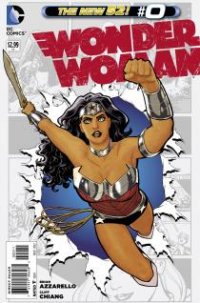
by D.S. Randlett (@dsrandlett)
Wonder Woman is a favorite for a couple of us here at Thor’s Comic Column, and for good reason. A year in, the series has managed to be thematically rich and feature a cast of compelling characters. What’s more, it pushes into some pretty philosophically radical territory without being dour or at all gritty. The vast majority of the time, anyway. So far the series seems to be a statement on individuality, with Wonder Woman as the central anchor for the reader. Like many of us, she’s recently had her world upended. For most readers, this probably means the loss of a job. For Diana Prince, this means the loss of a mother and the revelation that she was not, in fact, fashioned out of clay. In either case, it’s an upheaval of a sense of identity. A lot of us bind ourselves up in our jobs or degrees, and when those are stripped away a lot of people feel like they have nothing left, except for a question: Who am I? That’s the question that’s been on Wonder Woman’s mind for the duration of the Azzarello/Chiang run. After the absolute corker that was last month’s issue, I really didn’t want to spend this month on a flashback. After that last page, could you blame me for being impatient? Although it is a detour, it is not a wasted one. Azzarello’s script tells a story of one of teenaged Diana’s adventures on Themyscira. At this point she is still under the impression that she was fashioned out of clay by her mother, Hippolyta. The story is written in a style reminiscent of comics from the forties, and it’s a conceit that works to put the reader in a nostalgic frame of mind. When compared to the rest of the run, it mirrors the feeling that childhood was somehow more sure and stable than adulthood. The events of the story put the lie to that, however. Here we follow Diana’s tutelage in combat under War, who hopes to make her his replacement. The young Diana thinks she can trust War, and trust her mother, but they have their own visions for her future. The question is: do those visions fit? As the events of the story unfold, it is clear that they don’t. By the end we have a story about living in a world that has plans for us that aren’t necessarily for the best.
What caught my eye is a rather funny narration caption in the opening pages of the issue, wherein Azzarello seems to be addressing, sardonically and slyly, certain criticisms that his version of Wonder Woman and her world isn’t feminist (enough). I remember there being some controversy over Azzarello and Chiang showing a scene (pulled from mythology, it should be noted) portraying the Amazonian practice of boarding ships at sea, sleeping with the men on said ships, and then killing said men. The goal is for the Amazons to be impregnated, hopefully with daughters, as sons are apparently killed (unless they are rescued by the disfigured laborer god, Hephaestus). The criticism here is that Azzarello is sullying William Moulton Marston’s original vision of the Amazons as feminist warrior pacifists, and that this is somehow misogynistic. This particular issue seems to clarify what this series is about and what Wonder Woman stands for. Under Azzarello’s scheme, the Amazons (like the gods) are an institution, and institutions seek to subdue the individual. His Wonder Woman isn’t a warrior for women expressly, but a warrior for the individual. It’s a recurring theme in the series, and it encompasses everything from Hephaestus’s taking in of those who the Amazonian institution lets down to Wonder Woman’s own profession of love for Hades. And it’s worth noting that the Amazons are not portrayed as mindless “feminazis”, but rather prisoners of an ideology. Nonetheless, nearly every character that Wonder Woman has so far come into conflict with in this run has had that piece of individuality within them worth saving and loving, gods and Amazons alike. In this particular issue, this recurring motif is present in the character of War, who fulfills his office with aplomb but is getting increasingly weary of it. In taking the side of the individual here, Azzarello’s themes might not be “feminist” in the strictest sense, as his siding with the individual, masculine or feminine, against an array of institutions may not be strictly feminist, but it seems to me that it might encompass feminism. Chiang’s art is quite good here. He captures the feel of classic Wonder Woman stories within his own distinct style, which throughout this run has had a sense of lyricism that’s hard to pin down. His action doesn’t have much visceral impact, but it unfolds at a similar lyrical pace as the rest of his storytelling. This is for the best, as the unfolding of the series has revealed a story about clashing ideals of the Self, and the combat must do its part to convey those ideas. What we lack in widescreen superheroics is recompensed by a clear-eyed thematic focus on the part of the artist, a success in a run full of them.
Rating: 




Out of a Possible 5 Stars
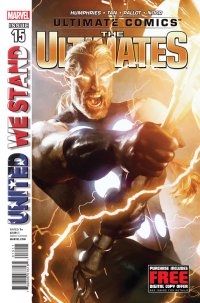 The Ultimates #15 (Marvel, $3.99)
The Ultimates #15 (Marvel, $3.99)
By Jeb D.
These days, where corporate popular culture is concerned, it gets harder and harder to decide whether you’re analyzing the product or the marketing. In order to court mainstream press coverage, Marvel has managed to spoil not only the development at the end of issue #15 of their revived Ultimates series (I think it’s technically called “Ultimate Comics’ The Ultimates,” but I may have overlooked an extra use or two of the word “Ultimate”), but have also given a peek at the ramifications it carries for issue #16.
And that’s rather a shame, as the careful world-building of this series has been highly enjoyable. Jonathan Hickman and new writer Sam Humphries have taken the Ultimate Universe into the sorts of places it always had the potential to visit (once past the creaky Jemas/Quesada concept of conquering the worlds of Target and Toys R Us): the United States has become a fragmented dystopia, most of the national government is dead or missing, Sentinels have been ceded huge chunks of territory, a feisty Texas has the bomb, and the West Coast, under the direction of a pair of Jobs/Gates-style visionaries, has decided to stem a refugee flood with the use of lethal robotic drones, developed by Henry Pym, and given the cynically ironic name of “wasps;” unsurprisingly, this leads to what seems an unstoppable massacre of those fleeing the tender mercies of the Sentinels.
Naturally, the country needs, more than ever, its recently-rediscovered symbol of unity, but Captain America has orders to stand down, rather than making things worse among the various factions. Well, not even the regular Marvel U Cap would obey an order like that, and you can imagine that the snarling, hard-bitten Ultimate Cap is no different, leading to sequences of Cap in action that are simultaneously inspirational and disquieting: some of what Humphries has been doing with the character reminds me of Steve Englehart’s days on the original Cap, where flying fists and spinning shield provided temporary solutions, but never completely put to rest the difficult question of state-sanctioned violence in the name of democracy. Ultimates has always been a book that tweaks and plays with contemporary politics, but rarely at the cost of telling a good story, and if Humphries has begun to sand down some of the rougher edges of Ultimate characters like Cap or Thor, that just allows him to heighten the contrast with the dark place that the Ultimate Universe has become.
Billy Tan’s art always strikes me as more serviceable than enjoyable, but after the dual-artist clusterfuck that was issue #14, I’m feeling a bit more generous about his work this time: the layouts may be uninspired, but there’s a few shots of Cap, shielding innocents from the wasp massacre, that beautifully convey his anger at a country that has devolved to the point of endangering its most vulnerable in the name of national security (speaking of political subtext); now if only they’d settled on just one colorist for the book, I’d have been able to add an extra half a star to this review.
No matter what the reader may have thought of Marvel’s decision to rewrite the Ultimate Universe by means of a biblical deluge a few years back (I like to think that David Finch moved on because he simply couldn’t bear to draw any more panels of water), they put that deck-cleaning to good use: it’s recently become a fascinating playground for superhero storytelling, with such developments as the replacement of the late Peter Parker with a black inner-city teenager, Reed Richards morphing into a deliciously hateful supervillain, and Tony Stark’s brain tumor developing sentience.
And on the odd chance that you haven’t seen USA Today lately, I won’t spoil the (not entirely logical) plot twist in this issue: if you’re not currently reading Ultimates, issue #15 would be a perfectly reasonable jumping-on point; and since Marvel’s already spoiling #16 for us, you’d better get on it fast!
Rating: 




Out of a Possible 5 Stars
Sword of Sorcery Featuring Amethyst #0 (DC, $3.99)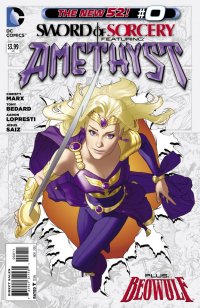
By Adam Prosser
I don’t, as a general rule, read reviews of a comic that I’m about to review myself until after this column is done. However, on Wednesday night I started to see a lot of grousing and snarking on my Twitter feed. As a few people have pointed out, people who are on Twitter and other social media a lot tend to hear about things as oblique references and jokes before we hear the actual news itself, so it crept up on me slowly, but eventually Chris Sims laid it out flat: “So there’s an attempted gang-rape in the first issue of Amethyst #0.”
Sims had, like me, been greatly looking forward to this comic book. The original Amethyst, published as a series of miniseries in the mid-80s, was an epic fantasy adventure featuring a girl named Amy Winston who discovered that she was the heir to a fantasy world based around gemstones, and that, Captain Marvel-like, she could become a fully-grown blonde bombshell warrior-sorceress whenever she chose. For reasons that didn’t actually make a lot of sense, but hey! Also she got a flying unicorn. The original book is decidedly weird in that 80s way, when comics were groping towards “edginess” and sophistication but still had a bit of the zany energy of the Silver Age and derived a lot of their concepts from Star Wars and Saturday morning cartoons. Despite a lot of stuff that makes you go “Wha…?” it’s a fun read. Oh, and needless to say, it’s a vestige of the era when an original comic with a female protagonist—I’d argue that it wasn’t particularly aimed at girl readers over boys, but again, the gender lines were less sharply drawn in entertainment back then—could actually be launched without some kind of major fanfare.
Here in 2012 we’re in a different place, culturally speaking, but the idea of reviving Amethyst is still a good one. There’s apparently going to be a short cartoon featuring the character in DC’s cartoon programming block, possibly leading to something ongoing, and the idea of trying to get a crossover audience is something comics desperately need. And it could still work, maybe…but the new Amethyst comic, written by the creator of Jem (!) Christy Marx and drawn by Aaron Loprestri, suffers from a lot of the same issues that have made mainstream superhero comics so inaccessible to a wider audience.
The sexual assault is definitely a main sticking point here. As a number of people have already pointed out, the original first issue of Amethyst features an attempted rape of the main character by a couple of troll-like monsters. That’s because comics have had certain endemic problems for quite a while now. But it does need to be said that it’s all about context. I’m not opposed to the idea of stories for younger girls having a harder edge—lord knows the Hunger Games, which has a huge female readership, puts its protagonist through a range of horrors—but the trouble, simply put, is that in DC comics, rape is starting to feel like a formula. A couple of weeks ago, I wrote about the new Carol Danvers Captain Marvel and how it crafted a Strong Female Character without resorting to tiresome clichés; as it turns out, I could have used this comic as a negative example. This version of Amy Winston breaks up a rape to show how badass she is, exactly the same way male DC characters do all the time. It’s the classic protesting-too-much male mindset that defines characters solely by making them into punching machines and ignores the underlying issues. It even seems like there might be some prurient interest involved: we can hypocritically boo-hiss at the rapist thugs, but there’s still a sexual element to the scene, which makes it extra-icky. The fact that this comic was written by a woman just makes it all the worse—the problem seems to be endemic to DC.
I guess this might be less of a big deal if the comic was really good, but it isn’t. “But other than that, Mrs. Lincoln, how was the play?” Well, it falls hostage to other issues, including a setup that’s become incredibly tiresome at this point: the teenage protagonist—WHO COULD BE YOU!!!!—who doesn’t fit in at school; she dyes her hair (gasp! choke! shudder!) and copes with snark, but is secretly a great person. Then she finds out she’s heir to a Great Destiny and is The Chosen One and blingedy bleah blah blah. It’s Genre By Numbers at this point; you could write it yourself. Even the Gemworld seems to have been blandified as a setting; the memorable villain Dark Opal apparently won’t be in this series, and what we see of it seems like a pretty off-the-rack fantasy world, without any of the bizarre touches original creators Gary Mishkin, Dan Cohn and Ernie Colon brought to it. (Though artist Aaron Lopresti does capture some of the art nouveau intricacy of Colon’s artwork.)
Granted, it’s early days yet, and this comic could still recover from an awkward start. But it’s really not a good sign when a comic manages to alienate seemingly everyone who was looking forward to it in the first issue. The last rays of hope in the fantasy kingdom of DC comics are being snuffed out, and it turns out this Chosen One doesn’t have what it takes to save it.
Rating: 




Out of a Possible 5 Stars
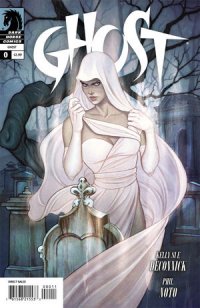 Ghost #0 (Dark Horse, $2.99)
Ghost #0 (Dark Horse, $2.99)
By Jeb D.
Dark Horse’s original Ghost series was my first look at artists like Adam Hughes and Terry Dodson, and given that it ran, in fits and starts, for several years (even managing crossovers with Batgirl, Hellboy, and The Shadow), could probably be counted as the greatest success of Dark Horse’s ill-fated “Comics’ Greatest World” universe. That said, it makes perfect sense that my most vivid memories of it are of artists particularly adept with the female form: the simple fact is that Ghost was a great character design in search of a character: Elisa Cameron’s dithering quest to discover who she really was, and what really happened to her, were a poor fit for the aggressively sexual costume and curves, to say nothing of the blazing twin automatics. That’s not to say that there weren’t a few decent storylines here and there, but there were too many stops, starts, unconvincing reveals and retcons; when one of a series’ great innovations is to use your covers for Photoshopping models cosplaying your character, it’s pretty obvious that details of plot and characterization are beside the point.
Writer Kelly Sue DeConnick is currently doing a wonderful job of revitalizing a similarly unfocused character: Marvel’s Carol Danvers, once Ms. Marvel, now Captain Marvel; while plenty of good writers have worked to integrate her into strong storylines in the past, no one before DeConnick ever completely got past the stripper’s costume and cascading blond tresses, so Dark Horse has certainly chosen the right author to attempt to reconstitute their less-than-blithe spirit. As to her success, the jury is certainly still out, but DeConnick’s track record suggests she’s more likely to make this work than not.
The story in this issue (collecting the recent installments from Dark Horse Presents #13-15) makes the key structural decision to place us outside Elisa’s consciousness: one of the problems with the previous Ghost series was that the character’s ambiguity (or do I mean editorial indecisiveness?) made the interior narration (just becoming the standard for comics at the time) a poor focus. But while it makes sense that our perspective on the character and events is a pair of broken-down, bickering reality-TV ghost hunters, I don’t know that DeConnick is all that invested in them as characters: they’re both kind of drippy, and their conflicts feel stale. In addition, when the sudden appearance of the ghostly form of Elisa Cameron (whom the pair believe to be a legendary spirit named “Resurrection Mary”) sets off a chain of grisly, horrifying events, their reactions feel bland, and they function as little more than props for our introduction to a phantasmic woman whose amorphous memories, and disturbing abilities, are just starting to be revealed. It’s intriguing enough to invest the reader in the next issue, but I hope that DeConnick’s plans to develop Ghost’s character will move along at a slightly brisker pace in future issues.
(Incidentally, at this point in the story, there’s no specific indication that this incarnation of Ghost, in fact, is Elisa Cameron at all, or that this version of Ghost will have any actual connection to the previous series–among other things, the famous twin automatics haven’t shown up yet; I’m making a few assumptions on that score, but I could easily see it going another way).
Like DeConnick, artist Phil Noto brings a track record that suggests him as the ideal choice for a series that, for better or worse, will rely heavily for its appeal on the exotic pulchritude of its title character, and there’s no question that while his version of Ghost is sumptuous to look at, he also manages to drive home the small hints of character that DeConnick has dropped so far; ghost hunters Tommy Byers and Vaughn Barnes are also rendered distinctively. What’s missing is anything in the way of atmosphere: the paneling is pretty straightforward, and while that might make for good contrast (the linearity of a TV broadcast versus the ominous prospect of a visit from a dead woman), he doesn’t really run with it: backgrounds are drab or nonexistent, and the unearthly events are presented so matter-of-factly that it’s hard to do much more than shrug at them.
Not a terrible start for the new series, but at this point, it’s mostly my confidence in DeConnick’s abilities (and hope that the flaws in Noto’s art might have reflected some kind of deadline pressure) that have me hopeful for future issues, more than anything actually in evidence this time around.
Rating: 




Out of a Possible 5 Stars
DC Super-Pets! (Various Titles, Picture Window Books, $4.95 ea)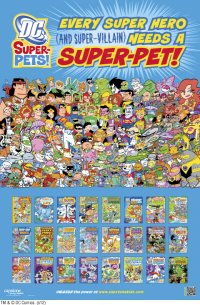
by Graig Kent
After thirty-plus years of comic book reading I’ve started to forget what it was like discovering the four-color worlds of DC, Marvel and the countless other publishers who came and went (and came and went again, and some who stayed). I have only the vaguest recollection of the joy I got from continually pouring over my scatter-shot collection of Who’s Who at age ten, trying to piece together roughly 50 years of continuity for hundreds of characters in my young brain. Every now and again I get a sense of that joy, discovering comic books from my past that I’d never heard of before, or never given a chance. Things like Tower’s T.H.U.N.D.E.R. Agents or Dave Cockrum’s Futurians do rekindle the flame when they reveal themselves to me, but watching my three-year-old with the Picture Window Books’ series of DC Super-Pets!, I realize I don’t get half the joy out of comics that I used to, because I don’t have the time to commit to them.
The DC Super-Pets! books kicked off with six titles back in 2011, and have had four additional “seasons” of six books each, the final wave hitting just recently, bringing the collection to a total of twenty four. The books are a showcase for illustrator Art Baltazar, the Eisner Award winning artist of Tiny Titans, and currently Superman Family Adventures, but here his illustrations are static, accompanying prose tales instead of sequential storytelling. His Charles Schulz-does-spandex aesthetic is as charming as it ever was, though drawing influences from many great cartoonists past, his style at this point is uniquely, and prevalently, his own. There’s a youthful joy to all of Baltazar’s illustrations, which is what draws my three-year-old to the book, and equally my ten-year-old to Tiny Titans, and lures adults –with and without kids alike– who admire great cartooning to anything he does.
The series features all the typical animal companions from DC Comics, with the Super- and Bat-themed pets obviously taking the fore. Krypto, Streaky, Comet and Ace are naturally the star pets, but there are also some more obscure characters from DC lore, like Rex the Wonder Dog, Storm, B’dg, Detective Chimp, Beppo, Proty and even Gleek getting some serious face time. Beyond those, Baltazar has included a couple of his favorite hero-pets he created in Tiny Titans like Robin Robin and Batcow, and created dozens upon dozens more new super-pets and villains. Including Plastic Man’s sidekick, Plastic Frog, Aqualad’s pet goldfish Fluffy, Wonder Woman’s kangaroo familiar Jumpa, Flash’s turtle pal Whatzit, and a whole crew of dogs and a slew of Green Lanterns. They square off against familiar villain pets like Starro, Red Lantern Dex-Starr, Mr. Mind and Titano, but beyond that are a slew of fresh, furry bad guys, from the Joker Fish, to Catwoman’s best puss Rozz, to Giganta’s giraffe Patches, the Mad Catter and Bizarro Krypto.
As each season of books was added, Baltazar expanded the 2-page splash that opens each book showcasing the entire roster of heroes and villains and their pets. By the fourth season (as you can see from the accompanying image) it got plenty busy indeed. To straighten things out, each book also features a two page “know your pets” spread. My daughter obsesses over this role call on a daily basis and spends much of her (and my) time committing the names and characters to memory. It’s not much different than what I used to do with those Who’s Who, only she’s started at an even younger age. One of the yellow lanterns is a stinkbug named Tootz, which makes her laugh every time I say it, and she seems obsessed with Robin Robin right now.
The stories all weigh in at around 48 pages with plenty of illustrations and colorfully and stylized words and effects noises to keep young eyes drawn to the page. For some reason these 3-chapter storybooks seem to hold my daughter’s attention far more than a 20-page comic book does. Prior to each story there’s profile pages of the hero and villains of the book, and after each story there’s a page of that book’s character’s telling jokes, the aforementioned “know your pets” spread and a visual spread of all the other books in the series. That last bit is another something my daughter equally obsesses over, looking at the small pictures of the other titles and picking out the next one she wants me to buy.
From an actual story perspective, the books are pretty juvenile, and sorely missing the sly humor that the Baltazar/Franco works do. The stakes within the stories are pretty low and the creepiness factor of the villains turned down to zero (there’s even a “Swamp Thing vs. the Zombie Pets” which fits right in with the spate of “spooktacular” family animated films this year). They’re written by a rotating cast of writers from the Picture WIndow Books stable, and their stories range from cute (Midway Monkey Madness), to kind of kooky capers (Barnyard Brainwash), to entertaining animal-centric superhero-romps (Candy Store Caper). The enjoyment I get as a long time comics fan comes more from seeing Baltazar’s crazier superhero and villain companions, as well as the kind of giddy sensation of seeing a kids book like Starro and the Space Dolphins, about Hawkman’s bird, Big Ted, and Lobo’s dog, Dawg, teaming up to hunt down Starro after he kidnaps Lobo’s space dolphins, or The Fantastic Flexy Frog in which Plastic Frog has to go toe to to with Killer Croc. My preferences have always leaned towards C-list characters so it tickles me that Baltazar plumbs the depths to create animal pals for less prominent figures.
These really are meant for kids though. I couldn’t see any childless adult actively reading this series on their own initiative any more than I could see a childless adult watching Disney Jr. all afternoon on their own volition. But if you do have kids, these are fun books to read to them, and good starter books to read with them. If your goal is to make them comics minutiae geeks (like yourself, maybe?) they seem specially manufactured to trigger that gene.
Rating: 




Out of a Possible 5 Stars